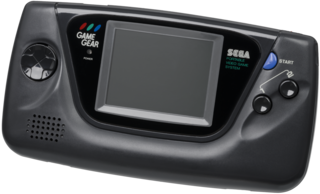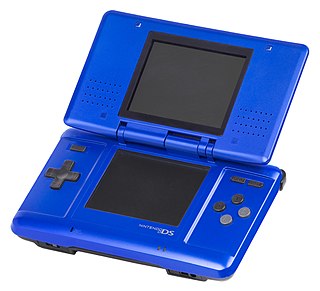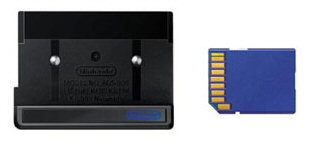
The Game Boy Advance (GBA) is a 32-bit handheld game console developed, manufactured and marketed by Nintendo as the successor to the Game Boy Color. It was released in Japan on March 21, 2001, in North America on June 11, 2001, in the PAL region on June 22, 2001, and in mainland China as iQue Game Boy Advance on June 8, 2004.

A handheld game console, or simply handheld console, is a small, portable self-contained video game console with a built-in screen, game controls and speakers. Handheld game consoles are smaller than home video game consoles and contain the console, screen, speakers, and controls in one unit, allowing players to carry them and play them at any time or place.

The Game Gear is an 8-bit fourth generation handheld game console released by Sega on October 6, 1990, in Japan, in April 1991 throughout North America and Europe, and during 1992 in Australia. The Game Gear primarily competed with Nintendo's Game Boy, the Atari Lynx, and NEC's TurboExpress. It shares much of its hardware with the Master System, and can play Master System games through the use of an adapter. Sega positioned the Game Gear, which had a full-color backlit screen with a landscape format, as a technologically superior handheld to the Game Boy.

The WonderSwan is a handheld game console released in Japan by Bandai. It was developed by Gunpei Yokoi's company Koto Laboratory and Bandai, and was the last piece of hardware Yokoi developed before his death in 1997. Released in 1999 in the sixth generation of video game consoles, the WonderSwan and its two later models, the WonderSwan Color and SwanCrystal were officially supported until being discontinued by Bandai in 2003. During its lifespan, no variation of the WonderSwan was released outside of Japan.

The Game Boy Player (DOL-017) is a GameCube peripheral developed by Nintendo which enables it to play Game Boy, Game Boy Color, and Game Boy Advance cartridges, allowing those games to be played on a television.

The Nintendo DS is a foldable handheld game console produced by Nintendo, released globally across 2004 and 2005. The DS, an initialism for "Developers' System" or "Dual Screen", introduced distinctive new features to handheld games: two LCD screens working in tandem, a built-in microphone and support for wireless connectivity. Both screens are encompassed within a clamshell design similar to the Game Boy Advance SP. The Nintendo DS also features the ability for multiple DS consoles to directly interact with each other over Wi-Fi within a short range without the need to connect to an existing wireless network. Alternatively, they could interact online using the now-defunct Nintendo Wi-Fi Connection service. Its main competitor was Sony's PlayStation Portable during the seventh generation of video game consoles.

The GameCube – Game Boy Advance cable (DOL-011) is a video game accessory manufactured by Nintendo which is used to connect the Game Boy Advance (GBA) handheld console to the GameCube (GCN) home console. Depending on the games it is used with, the cable may facilitate transferring data between related games, unlocking additional content, or turning the GBA into a controller or second screen.
A frontlight is a means of illuminating a display device, usually a liquid crystal display (LCD), which would otherwise be viewed in ambient light. This improves its performance in poor lighting conditions.
Game Boy Advance Video is a format for putting full color, full-motion videos onto Game Boy Advance ROM cartridges. These videos are playable using the Game Boy Advance system's screen and sound hardware. They were all published by Majesco Entertainment, except for the Pokémon Game Boy Advance Video cartridges, which were published by Nintendo. Most cartridges were developed by DC Studios, Inc., except for the few labelled "Movie Pak" which were developed by 4Kids Entertainment's subsidiary 4Kids Technology, Inc. The video cartridges are colored white for easy identification and are sold as Game Boy Advance Video Paks; these offer the same 240×160 resolution as standard Game Boy Advance games, except for the Shrek and Shark Tale pack, which is at 112p.

WarioWare: Twisted! is a video game for the Game Boy Advance, developed by Nintendo SPD with Intelligent Systems and published by Nintendo. It was released on October 14, 2004 in Japan; May 19, 2005 in Australia; and May 23, 2005 in North America. The second game in the WarioWare series and the seventh in the Wario series overall, Twisted! was the last Wario game to be released on a Game Boy family system.

The Play-Yan is a media player designed for the Game Boy Advance SP and also compatible with the Game Boy Micro and Nintendo DS. It uses SD flash memory to play MP3 audio files and H.264/MPEG-4 AVC video files. It can also play 13 bonus mini-games, all of which are available freely on the Nintendo website in Japan. Sales of the Play-Yan were discontinued on September 11, 2005.

The Game Boy Micro is a handheld game console developed and manufactured by Nintendo. It was first released in Japan on September 13, 2005 as a smaller, lighter redesign of the Game Boy Advance. The system is the last Game Boy handheld, alongside the AGS-101 model of the Game Boy Advance SP. Unlike its predecessors, the Game Boy Micro lacks backward compatibility for original Game Boy and Game Boy Color games.

The Nintendo DS Lite is a foldable handheld game console developed and manufactured by Nintendo. It is the second iteration of the Nintendo DS and is slimmer, brighter, and more lightweight than the original. It was announced on January 26, 2006, more than a month before its initial release in Japan on March 2, 2006 due to overwhelming demand for the original model. It has been released in Australia, North America, Europe, New Zealand, Singapore, and defined regions in South America, the Middle East, and East Asia. As of March 31, 2014, the DS Lite had shipped 93.86 million units worldwide.

The Game Boy is an 8-bit, fourth generation, handheld game console developed by Nintendo, launched in the Japanese home market on April 21, 1989, followed by North America and Europe later that year. Designed by the team behind the Game & Watch handhelds and NES games, it was Nintendo's first portable console, combining features from both.

The Nintendo Game Link Cable is an accessory for the Game Boy line of handheld video game systems, allowing players to connect Game Boys of all types for multiplayer gaming. Depending on the games, a Game Link Cable can be used to link two games of the same title, like Tetris, or two compatible games like Pokémon Red and Blue. Games can be linked for head-to-head competition, cooperative play, trading items, unlocking hidden features, etc.
This is a list of video game accessories that have been released for the Game Boy handheld console and its successors. Accessories add functionality that the console would otherwise not have.

The Visteon Dockable Entertainment System is a portable DVD player created by Visteon in 2006 for the US market at an MSRP of $1299 USD. The player is notable for containing officially licensed Game Boy Advance hardware, as Visteon partnered with Nintendo to announce the product at CES 2006. Initially due out in April, the product was then delayed to May before finally launching in July of that year. To celebrate the product's launch Visteon held a photography and writing contest.















